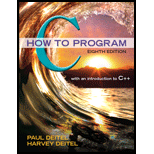
C How to Program (8th Edition)
8th Edition
ISBN: 9780133976892
Author: Paul J. Deitel, Harvey Deitel
Publisher: PEARSON
expand_more
expand_more
format_list_bulleted
Question
Chapter 6, Problem 6.24E
(a)
Program Plan Intro
To draw the 8-by-8 chessboard on a sheet and estimate the distance that can be covered, the distance covered and how close it was to the estimate.
(b)
Program Plan Intro
Program Plan-
Program to trace the moves made by a knight on a chess board, is given below.
• Include header files.
• Create functions clearBoard() ,printBoard() and validMove()
• Initialize main function
• Display all the moves toured by the knight.
Program Description- The purpose of the program is to implement the logic that will move the knight around a chessboard.
Expert Solution & Answer
Want to see the full answer?
Check out a sample textbook solution
Students have asked these similar questions
I need help to solve the following case, thank you
hi I would like to get help to resolve the following case
Could you help me to know features of the following concepts:
- defragmenting.
- dynamic disk.
- hardware RAID
Chapter 6 Solutions
C How to Program (8th Edition)
Ch. 6 - Fill in the blanks in each of the following: C...Ch. 6 - State which of the following are true and which...Ch. 6 - Write statements to accomplish each of the...Ch. 6 - Consider a 2-by-5 integer array t. Write a...Ch. 6 - (Sales Commissions) Use a one-dimensional array to...Ch. 6 - (Bubble Sort) The bubble sort presented in Fig....Ch. 6 - Write loops that perform each of the following...Ch. 6 - Prob. 6.13ECh. 6 - (Mean, Median and Mode Program Modifications)...Ch. 6 - (Duplicate Elimination) Use a one-dimensional...
Ch. 6 - Label the elements of 3-by-5 two-dimensional array...Ch. 6 - What does the following program do?Ch. 6 - What does the following program do?Ch. 6 - (Dice Rolling) Write a program that simulates the...Ch. 6 - (Game of Craps) Write a program that runs 1000...Ch. 6 - Prob. 6.21ECh. 6 - (Total Sales) Use a two-dimensional array to solve...Ch. 6 - (Turtle Graphics) The Logo language made the...Ch. 6 - Prob. 6.24ECh. 6 - (Knights Tour: Brute-Force Approaches) In Exercise...Ch. 6 - (Eight Queens) Another puzzler for chess buffs is...Ch. 6 - (Eight Queens: Brute-Force Approaches) In this...Ch. 6 - (Duplicate Elimination) In Chapter 12, we explore...Ch. 6 - (Knights Tour: Closed Tour Test) In the Knights...Ch. 6 - (The Sieve of Eratosthenes) A prime integer is any...Ch. 6 - Prob. 6.31RECh. 6 - (Linear Search) Modify the program of Fig. 6.18 to...Ch. 6 - (Binary Search) Modify the program of Fig. 6.19 to...Ch. 6 - Prob. 6.35RECh. 6 - Prob. 6.36RECh. 6 - Prob. 6.37RE
Knowledge Booster
Similar questions
- what is a feature in the Windows Server Security Compliance Toolkit, thank you.arrow_forwardYou will write a program that allows the user to keep track of college locations and details about each location. To begin you will create a College python class that keeps track of the csollege's unique id number, name, address, phone number, maximum students, and average tuition cost. Once you have built the College class, you will write a program that stores College objects in a dictionary while using the College's unique id number as the key. The program should display a menu in this order that lets the user: 1) Add a new College 2) Look up a College 4) Delete an existing College 5) Change an existing College's name, address, phone number, maximum guests, and average tuition cost. 6) Exit the programarrow_forwardShow all the workarrow_forward
- Show all the workarrow_forward[5 marks] Give a recursive definition for the language anb2n where n = 1, 2, 3, ... over the alphabet Ó={a, b}. 2) [12 marks] Consider the following languages over the alphabet ={a ,b}, (i) The language of all words that begin and end an a (ii) The language where every a in a word is immediately followed by at least one b. (a) Express each as a Regular Expression (b) Draw an FA for each language (c) For Language (i), draw a TG using at most 3 states (d) For Language (ii), construct a CFG.arrow_forwardQuestion 1 Generate a random sample of standard lognormal data (rlnorm()) for sample size n = 100. Construct histogram estimates of density for this sample using Sturges’ Rule, Scott’s Normal Reference Rule, and the FD Rule. Question 2 Construct a frequency polygon density estimate for the sample in Question 1, using bin width determined by Sturges’ Rule.arrow_forward
- Generate a random sample of standard lognormal data (rlnorm()) for sample size n = 100. Construct histogram estimates of density for this sample using Sturges’ Rule, Scott’s Normal Reference Rule, and the FD Rule.arrow_forwardCan I get help with this case please, thank youarrow_forwardI need help to solve the following, thank youarrow_forward
arrow_back_ios
SEE MORE QUESTIONS
arrow_forward_ios
Recommended textbooks for you
 C++ for Engineers and ScientistsComputer ScienceISBN:9781133187844Author:Bronson, Gary J.Publisher:Course Technology Ptr
C++ for Engineers and ScientistsComputer ScienceISBN:9781133187844Author:Bronson, Gary J.Publisher:Course Technology Ptr C++ Programming: From Problem Analysis to Program...Computer ScienceISBN:9781337102087Author:D. S. MalikPublisher:Cengage Learning
C++ Programming: From Problem Analysis to Program...Computer ScienceISBN:9781337102087Author:D. S. MalikPublisher:Cengage Learning Operations Research : Applications and AlgorithmsComputer ScienceISBN:9780534380588Author:Wayne L. WinstonPublisher:Brooks Cole
Operations Research : Applications and AlgorithmsComputer ScienceISBN:9780534380588Author:Wayne L. WinstonPublisher:Brooks Cole- Programming Logic & Design ComprehensiveComputer ScienceISBN:9781337669405Author:FARRELLPublisher:Cengage
 EBK JAVA PROGRAMMINGComputer ScienceISBN:9781305480537Author:FARRELLPublisher:CENGAGE LEARNING - CONSIGNMENT
EBK JAVA PROGRAMMINGComputer ScienceISBN:9781305480537Author:FARRELLPublisher:CENGAGE LEARNING - CONSIGNMENT New Perspectives on HTML5, CSS3, and JavaScriptComputer ScienceISBN:9781305503922Author:Patrick M. CareyPublisher:Cengage Learning
New Perspectives on HTML5, CSS3, and JavaScriptComputer ScienceISBN:9781305503922Author:Patrick M. CareyPublisher:Cengage Learning

C++ for Engineers and Scientists
Computer Science
ISBN:9781133187844
Author:Bronson, Gary J.
Publisher:Course Technology Ptr

C++ Programming: From Problem Analysis to Program...
Computer Science
ISBN:9781337102087
Author:D. S. Malik
Publisher:Cengage Learning

Operations Research : Applications and Algorithms
Computer Science
ISBN:9780534380588
Author:Wayne L. Winston
Publisher:Brooks Cole

Programming Logic & Design Comprehensive
Computer Science
ISBN:9781337669405
Author:FARRELL
Publisher:Cengage

EBK JAVA PROGRAMMING
Computer Science
ISBN:9781305480537
Author:FARRELL
Publisher:CENGAGE LEARNING - CONSIGNMENT

New Perspectives on HTML5, CSS3, and JavaScript
Computer Science
ISBN:9781305503922
Author:Patrick M. Carey
Publisher:Cengage Learning